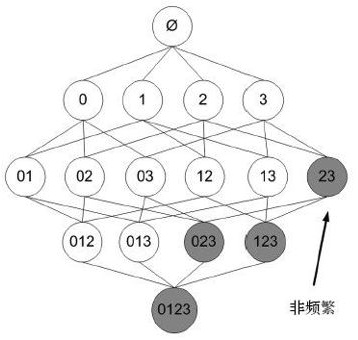先验算法(Apriori Algorithm)是关联规则学习的经典算法之一。先验算法的设计目的是为了处理包含交易信息内容的数据库(例如,顾客购买的商品清单,或者网页常访清单。)而其他的算法则是设计用来寻找无交易信息(如Winepi算法和Minepi算法)或无时间标记(如DNA测序)的数据之间的联系规则。关联分析的目的是从大规模数据集中寻找有趣关系的任务。这些关系可以有两种形式:频繁项集或者关联规则。频繁项集(frequent item sets)是指经常出现在一起的物品的集合,关联关系(association rules)暗示两种物品之间可能存在很强的关系。
先验算法采用广度优先搜索算法进行搜索并采用树结构来对候选项目集进行高效计数。它通过长度为 k-1的候选项目集来产生长度为k的候选项目集,然后从中删除包含不常见子模式的候选项。根据向下封闭性引理,该候选项目集包含所有长度为 k的频繁项目集。之后,就可以通过扫描交易数据库来决定候选项目集中的频繁项目集。

from __future__ import division, print_function
import numpy as np
import itertools
class Rule():
def __init__(self, antecedent, concequent, confidence, support):
self.antecedent = antecedent
self.concequent = concequent
self.confidence = confidence
self.support = support
class Apriori():
"""A method for determining frequent itemsets in a transactional database and
also for generating rules for those itemsets.
Parameters:
-----------
min_sup: float
The minimum fraction of transactions an itemets needs to
occur in to be deemed frequent
min_conf: float:
The minimum fraction of times the antecedent needs to imply
the concequent to justify rule
"""
def __init__(self, min_sup=0.3, min_conf=0.81):
self.min_sup = min_sup
self.min_conf = min_conf
self.freq_itemsets = None # List of freqeuent itemsets
self.transactions = None # List of transactions
def _calculate_support(self, itemset):
count = 0
for transaction in self.transactions:
if self._transaction_contains_items(transaction, itemset):
count += 1
support = count / len(self.transactions)
return support
def _get_frequent_itemsets(self, candidates):
""" Prunes the candidates that are not frequent => returns list with
only frequent itemsets """
frequent = []
# Find frequent items
for itemset in candidates:
support = self._calculate_support(itemset)
if support >= self.min_sup:
frequent.append(itemset)
return frequent
def _has_infrequent_itemsets(self, candidate):
""" True or false depending on the candidate has any
subset with size k - 1 that is not in the frequent itemset """
k = len(candidate)
# Find all combinations of size k-1 in candidate
# E.g [1,2,3] => [[1,2],[1,3],[2,3]]
subsets = list(itertools.combinations(candidate, k - 1))
for t in subsets:
# t - is tuple. If size == 1 get the element
subset = list(t) if len(t) > 1 else t[0]
if not subset in self.freq_itemsets[-1]:
return True
return False
def _generate_candidates(self, freq_itemset):
""" Joins the elements in the frequent itemset and prunes
resulting sets if they contain subsets that have been determined
to be infrequent. """
candidates = []
for itemset1 in freq_itemset:
for itemset2 in freq_itemset:
# Valid if every element but the last are the same
# and the last element in itemset1 is smaller than the last
# in itemset2
valid = False
single_item = isinstance(itemset1, int)
if single_item and itemset1 < itemset2:
valid = True
elif not single_item and np.array_equal(itemset1[:-1], itemset2[:-1]) and itemset1[-1] < itemset2[-1]:
valid = True
if valid:
# JOIN: Add the last element in itemset2 to itemset1 to
# create a new candidate
if single_item:
candidate = [itemset1, itemset2]
else:
candidate = itemset1 + [itemset2[-1]]
# PRUNE: Check if any subset of candidate have been determined
# to be infrequent
infrequent = self._has_infrequent_itemsets(candidate)
if not infrequent:
candidates.append(candidate)
return candidates
def _transaction_contains_items(self, transaction, items):
""" True or false depending on each item in the itemset is
in the transaction """
# If items is in fact only one item
if isinstance(items, int):
return items in transaction
# Iterate through list of items and make sure that
# all items are in the transaction
for item in items:
if not item in transaction:
return False
return True
def find_frequent_itemsets(self, transactions):
""" Returns the set of frequent itemsets in the list of transactions """
self.transactions = transactions
# Get all unique items in the transactions
unique_items = set(item for transaction in self.transactions for item in transaction)
# Get the frequent items
self.freq_itemsets = [self._get_frequent_itemsets(unique_items)]
while(True):
# Generate new candidates from last added frequent itemsets
candidates = self._generate_candidates(self.freq_itemsets[-1])
# Get the frequent itemsets among those candidates
frequent_itemsets = self._get_frequent_itemsets(candidates)
# If there are no frequent itemsets we're done
if not frequent_itemsets:
break
# Add them to the total list of frequent itemsets and start over
self.freq_itemsets.append(frequent_itemsets)
# Flatten the array and return every frequent itemset
frequent_itemsets = [
itemset for sublist in self.freq_itemsets for itemset in sublist]
return frequent_itemsets
def _rules_from_itemset(self, initial_itemset, itemset):
""" Recursive function which returns the rules where confidence >= min_confidence
Starts with large itemset and recursively explores rules for subsets """
rules = []
k = len(itemset)
# Get all combinations of sub-itemsets of size k - 1 from itemset
# E.g [1,2,3] => [[1,2],[1,3],[2,3]]
subsets = list(itertools.combinations(itemset, k - 1))
support = self._calculate_support(initial_itemset)
for antecedent in subsets:
# itertools.combinations returns tuples => convert to list
antecedent = list(antecedent)
antecedent_support = self._calculate_support(antecedent)
# Calculate the confidence as sup(A and B) / sup(B), if antecedent
# is B in an itemset of A and B
confidence = float("{0:.2f}".format(support / antecedent_support))
if confidence >= self.min_conf:
# The concequent is the initial_itemset except for antecedent
concequent = [itemset for itemset in initial_itemset if not itemset in antecedent]
# If single item => get item
if len(antecedent) == 1:
antecedent = antecedent[0]
if len(concequent) == 1:
concequent = concequent[0]
# Create new rule
rule = Rule(
antecedent=antecedent,
concequent=concequent,
confidence=confidence,
support=support)
rules.append(rule)
# If there are subsets that could result in rules
# recursively add rules from subsets
if k - 1 > 1:
rules += self._rules_from_itemset(initial_itemset, antecedent)
return rules
def generate_rules(self, transactions):
self.transactions = transactions
frequent_itemsets = self.find_frequent_itemsets(transactions)
# Only consider itemsets of size >= 2 items
frequent_itemsets = [itemset for itemset in frequent_itemsets if not isinstance(
itemset, int)]
rules = []
for itemset in frequent_itemsets:
rules += self._rules_from_itemset(itemset, itemset)
# Remove empty values
return rules




 本文介绍了Apriori算法,一种用于关联规则学习的经典算法。它主要用于处理包含交易信息的数据库,如顾客购买的商品清单等。文章详细解释了算法的工作原理,并提供了一个Python实现示例。
本文介绍了Apriori算法,一种用于关联规则学习的经典算法。它主要用于处理包含交易信息的数据库,如顾客购买的商品清单等。文章详细解释了算法的工作原理,并提供了一个Python实现示例。
















 3429
3429

 被折叠的 条评论
为什么被折叠?
被折叠的 条评论
为什么被折叠?








